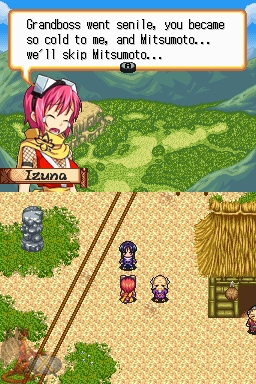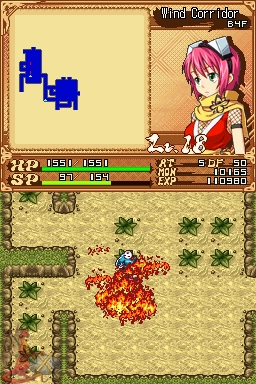|
|

|
PLATFORM
|
DS
|
BATTLE SYSTEM
|

|
INTERACTION
|

|
ORIGINALITY
|

|
STORY
|

|
MUSIC & SOUND
|

|
VISUALS
|

|
CHALLENGE
|
Unbalanced
|
COMPLETION TIME
|
Less than 20 Hours
|
|
OVERALL

|
+ Looks and sounds cute
- Randomness determines all
- Very repetitive
|
Click here for scoring definitions
|
|
|
Izuna is the most Valley Girl-esque ninja to ever be portrayed, and she's on a trip with her affectionately-titled Grandboss, her honorary sister Shino, and annoying tagalong brother Mitsumoto to find a home. Their latest village visitation isn't going very well, when Izuna manages to anger the six gods who protect this village. Having done so they proceed to curse everyone under their aegis, including Izuna's beloved Grandboss and Shino (along with her not-so-beloved Mitsumoto). Unable to stand being alone in the world, Izuna takes it upon herself to discuss the situation with the gods. The gods do not dwell in convenient little houses, and Izuna must venture into their dungeon domains to converse properly.
That's the story; Izuna running into each god or goddess, fighting it out with him/her, and being able to rouse some of the people in the village from their curses. Who she is able to free from curses determines what functions can be performed outside of a dungeon; at first all Izuna can do is save at the Inn and patronize the store. Later a woman who can hold items and money outside the normal rules of dungeon conduct, a man who can repair weapons, and a man who sells Talismans will become uncursed and able to offer their services. Aside from Izuna being one of the unlikeliest heroines ever, and her dialogue being alternately amusing and aggrieving because of that, the story is pedestrian.
As Izuna is a Rogue-like title, the story is inconsequential. Fighting through the dungeons is the heart and soul of it. Should Izuna be defeated in a dungeon, she will be rescued by gregarious passersby, experience and level intact. Money and items will be lost in defeat however. Izuna can move in any of 8 directions while traversing the dungeons, as can enemies. Each time Izuna takes a step, uses an item, or launches an attack, it counts as one action for every enemy in the dungeon as well. Therefore if Izuna is encircled by multiple opponents death is almost certain. In a one-on-one fight, there is little strategy to be used; Izuna attacks, her opponent attacks, and one of them will go down. Merely by walking around Izuna's HP recharge, at a rate of .5% per step. She can also 'skip,' or move in place, to recharge HP without potentially blundering into new enemies.
 Izuna the soap opera, coming soon to daytime TV!
Izuna the soap opera, coming soon to daytime TV!
|
|
There are times, many times, when the method of movement to restore HP is not enough. It is at times such as this that the random aspect of Izuna's design begins to become a problem. If Izuna was able to find healing items in the dungeon, excellent. Should Izuna not have found any, she will oftentimes die. At other times Izuna should be able to dispatch an enemy without great difficulty, but may miss so many strikes as to lose instead. There is only one weapon in the game that does not miss, and if Izuna is still beaten into oblivion while holding this weapon the usual random missing will recur.
Izuna's first two dungeons are fairly simple, short affairs to introduce the player to the game's nuances. The third dungeon is where the game introduces the horrid trap factor, and traps are very dangerous. Two traps could be deemed beneficial: one increases Izuna's attack power for the duration of the floor, the other causes her to float for awhile and thus avoid anything dangerous on the ground. The other traps cause a variety of effects: one causes damage and destroys a flammable item, one causes Izuna to randomly drop her items, one throws Izuna into a wall and halves her HP, another paralyzes her for a time, and there are more traps also with the most dangerous summoning a host of enemies to instantly surround Izuna. Should the trap gauntlet not be sufficient, in the fourth dungeon the concept of limited visibility is introduced; outside of rooms (meaning in the corridors that link rooms together) Izuna can only see immediately adjacent to herself. Usually the map that generates on the top screen provides red dots to give a warning of enemy approach, making this detrimental.
Equipment is fairly basic; Izuna finds claws, armlets, and swords within the dungeons. These items are indeed effective against certain foes but lack much visible correlation in Izuna's actual statistics. Oddly her attack and defense are always fixed at 5 minus any equipment, regardless of level. Equipment seems to affect this based on a visible statistic increase, but the corresponding damage increases to enemies and decreases to Izuna do not occur. Weapons can also break, a process accelerated by sticking Talismans onto them that grant additional effects. A broken weapon can be fixed by finding a using a certain Talisman or by returning to the village, though the only means of doing this aside from death also depends upon a certain Talisman being in the player's possession. And items in the player's possession are very finite, with lengthier dungeons requiring constant juggling and jettisoning of unwanted items to make room for whatever the player deems vital.
 Something blew up for no discernable reason, rather like a Michael Bay movie.
Something blew up for no discernable reason, rather like a Michael Bay movie.
|
|
Visuals are distinct and cute. Having said this, it behooves me to state that nothing here is visibly beyond what the GBA could have accommodated save the map generation on the DS's top screen. At least the audio is quite nice; Atlus left the inconsequential voices in Japanese and the music, while not standout material, is very soothing with an Eastern focus in its instrumentation.
Could Izuna be completed without dying, it would probably be done in three hours. But it cannot be completed without dying multiple times. As the challenge is essentially random based upon what enemies, traps, items, and layouts the game decides to throw into the player's path, properly predicting the time necessary to complete it is very difficult and I will venture no further than to say 20 hours ought to be too much. As for replay, there is a bonus dungeon at the end that starts Izuna from level 1 again for all the RPGamers that might tempt.
Certainly there are players who doubtless find the descriptions of the numerous ways Izuna creates challenge through unpredictability enticing. And to all RPGamers who find such a concept enthralling, Izuna just might be a buried treasure. To all other RPGamers without a penchant for pain and who like having the ability to fight back against the whims of the AI with some hope for survival, stay away. The moments of frustation inducement in this game are many, and damage to a DS may be the result of a player's experience in encountering the dreaded enemy that can reduce levels.
Review Archives
|









